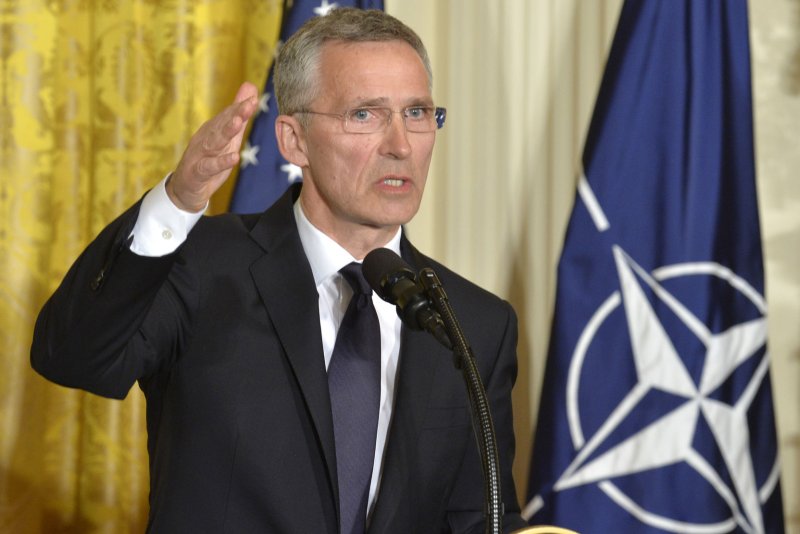NATO Secretary General Jens Stoltenberg makes remarks during a news conference with President Donald Trump in the East Room of the White House, April 12, 2017, in Washington, DC. Trump questioned American commitment to NATO during his campaign but has approved Montenegro's joining the alliance amid increasing tension with Russia. Photo by Mike Theiler/UPI |
License Photo
MOSCOW -- Black holes are not merely matters of physics. Strategic black holes may be even more confounding than those found in deep space. NATO, thus far history's most successful military alliance, currently must deal with three of them. The likelihood that this venerable alliance will do so is far from certain.
The first black hole regards strategy. Russian intervention into Ukraine and seizure of Crimea were chastening and frightening. So too, Russian "active measures" are roiling politics on both sides of the Atlantic. Russian engagement in Syria has sustained the diabolical regime of Bashar al-Assad. And Russia has become far more visible in Libya and the Persian Gulf.
While NATO has created new strategic concepts to deal with the end of the Cold War and the demise of the Soviet Union, its last real strategic revision was the Harmel Report of 1967. Led by Belgian Foreign Minister Pierre Harmel, his commission was charged with confronting the threat of Soviet increases in both nuclear and conventional weaponry and Charles De Gaulle's decision to eject NATO from Paris, leaving the military side of the alliance. The result was a shift from reliance solely on nuclear deterrence to a strategy of flexible response to deny Moscow advantages at all levels of the conflict spectrum.
The brilliance of flexible response was resolving the political conundrum dividing both sides of the Atlantic. Americans were not keen to trade Boston for Bonn if war became nuclear. Hence, increasing conventional capabilities to deter a Warsaw Pact assault westward was Washington's choice. Europeans viewed nuclear deterrence as a way of minimizing defense spending. Flexible response enabled both Washington and the continent to emphasize defense or deterrence without breaking the alliance.
Today, NATO's responses to Russian actions reflect 20th- and not 21st-century thinking and concepts. Russian President Vladimir Putin has no intention of embarking on a war with NATO. Instead, his policies rely on more than blunt military force. While stationing four battalions in the Baltics and rotating a Brigade Combat Team through Poland may reassure allies, Moscow is not impressed.
What NATO needs is a new strategy to deal with these realities, as well as one to deal with the second black hole, namely countering Russian "active measures," or what some call asymmetric war. NATO should move to a strategy of "porcupine defense," especially for its eastern-most members. The underlying concept is to bloody and blunt any attack so badly, that under no circumstances would Moscow even consider using military force.
Weapons systems such as Javelin anti-tank and anti-vehicle missiles and surface-to-air guided missiles such as the Stinger and Patriot would be acquired in very large numbers. The use of drones, possibly in the thousands, likewise would make any attack, however unlikely, too expensive to consider. And home guards to wage guerilla and insurgent war would be put in place, as well. Meanwhile, NATO members with larger ground, air and naval forces would be geared for reinforcement. But this, while necessary, is not sufficient.
Russian active measures include cyber, propaganda, disinformation, misinformation, intimidation and political interference among others. NATO has thus far little to no capability to counter these measures. NATO must begin an immediate effort to fill this black hole.
The final black hole concerns acquisition of weapons systems. These processes simply take too long, are too cumbersome and are not capable of keeping up with dramatic advances of technology. NATO and its members must move now to deal with this third black hole.
It is too soon to determine the impact of Brexit, populism and the ongoing elections in France and then in Germany on the alliance, as well as the actual commitment of the Trump White House to NATO. But, regardless, a new Harmel Commission for the 21st century is needed now. Whether the alliance will listen and whether anyone will lead are the vital questions on which NATO's future rests.
Harlan Ullman has served on the Senior Advisory Group for Supreme Allied Commander Europe (2004-16) and is a senior adviser at Washington, D.C.'s Atlantic Council and Business Executives for National Security; chairman of two private companies; and principal author of the doctrine of shock and awe. His next book, due out this year, is "Anatomy of Failure: Why America Loses Wars It Starts," which argues failure to know and to understand the circumstances in which force is used guarantees failure. Follow him on Twitter @harlankullman.















